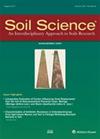在澳大利亚潮湿的热带地区,农药通过甘蔗下的渗透带运输
4区 农林科学
Q2 Agricultural and Biological Sciences
引用次数: 0
摘要
摘要光系统II (PS II)农药被认为是对生态健康的威胁,是大堡礁(GBR)流域甘蔗种植减少的目标。替代除草剂,非psii除草剂(包括草甘膦、百草枯、2,4- d、异马唑、异草柳酮、异甲草胺和s -异甲草胺)继续在这些流域中使用。然而,非ps II除草剂在使用方案、当地降雨模式和入渗动态方面的潜在生态命运、运输和场外环境影响尚未得到研究。2017-2019年,在GBR集水区甘蔗地地下安装了一个渗透区监测系统,用于实时追踪农药在不饱和区越过根区的迁移。常用农药氟嘧菌酯和二恶氟唑通过不饱和区迁移。氟氧吡啶在施用1个月内,渗透深度达到2.87 m,浓度随深度下降。每年使用的异草氟唑仅在2018年11月在土壤剖面的3.28 m深度被发现一次。同期施用的其他农药(异马唑、异甲草胺、草甘膦和氟草磷)未在渗透区检测到。然而,在监测期间没有在现场施用吡虫啉的情况下,在整个vadosezone中都检测到吡虫啉,显示出对降解的显著抵抗。结果显示,在研究结束时,没有任何证据表明在现场钻孔中有任何定期施用农药,这表明它们在到达地下水之前在渗透区内最终降解。本文章由计算机程序翻译,如有差异,请以英文原文为准。
Pesticide transport through the vadose zone under sugarcane in the Wet Tropics, Australia
Abstract. Photosystem II (PS II) pesticides, recognized as a threat
to ecological health, were targeted for reduction in sugarcane farming in
Great Barrier Reef (GBR) catchments. Alternative herbicides, the non-PS
II herbicides (including glyphosate, paraquat, 2,4-D, imazapic,
isoxaflutole, metolachlor, and S-metolachlor), continue to be used in these
catchments. However, the potential ecological fate, transport, and off-site
environmental effects of non-PS II herbicides, with respect to their usage
scheme, local rainfall patterns, and infiltration dynamics, have not been
investigated previously. A vadose zone monitoring system, instrumented
beneath sugarcane land in a GBR catchment, was applied for real-time
tracing of pesticide migration across the unsaturated zone, past the root
zone during 2017–2019. The regularly applied pesticides (fluroxypyr and
isoxaflutole) exhibited substantial migration through the unsaturated zone.
Within 1 month of application of fluroxypyr, it leached to 2.87 m depth
in the vadose zone, with declining concentrations with depth. Isoxaflutole,
which was applied yearly, was found only once, in November 2018, at 3.28 m depth in the soil profile. Other pesticides (imazapic, metolachlor,
glyphosate, and haloxyfop) applied during the same period were not detected
in the vadose zone. However, imidacloprid, which was not applied at the
site during the monitored period, was detected across the entire vadose
zone, revealing substantial resistance to degradation. The results show no
evidence of any regularly applied pesticides in the site bores at the end of
the study, indicating their ultimate degradation within the vadose zone
before reaching the groundwater.
求助全文
通过发布文献求助,成功后即可免费获取论文全文。
去求助
来源期刊

Soil Science
农林科学-土壤科学
CiteScore
2.70
自引率
0.00%
发文量
0
审稿时长
4.4 months
期刊介绍:
Cessation.Soil Science satisfies the professional needs of all scientists and laboratory personnel involved in soil and plant research by publishing primary research reports and critical reviews of basic and applied soil science, especially as it relates to soil and plant studies and general environmental soil science.
Each month, Soil Science presents authoritative research articles from an impressive array of discipline: soil chemistry and biochemistry, physics, fertility and nutrition, soil genesis and morphology, soil microbiology and mineralogy. Of immediate relevance to soil scientists-both industrial and academic-this unique publication also has long-range value for agronomists and environmental scientists.
 求助内容:
求助内容: 应助结果提醒方式:
应助结果提醒方式:


